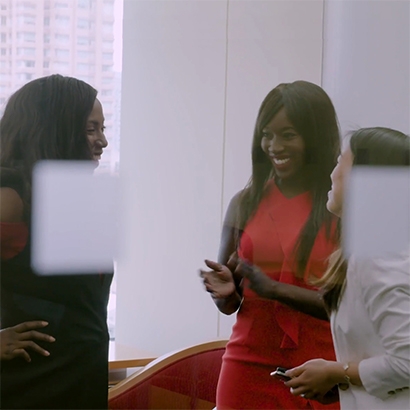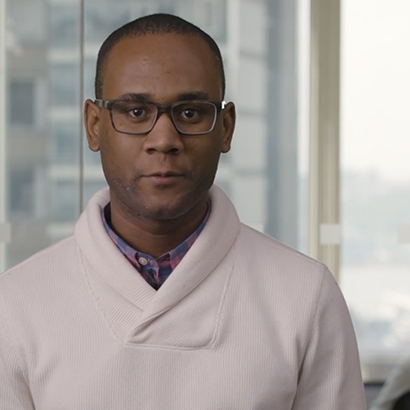Gaining the right introductions can make or break a fledgling business.
As many business founders know, it’s one thing to have a terrific idea for a company, and another thing entirely to identify and enlist the right people to turn that idea into a successful enterprise.
That’s why networking opportunities are such a vital part of the Multicultural Innovation Lab, Morgan Stanley’s accelerator program for technology and technology enabled companies. Each entrepreneur selected for the program receives a dedicated mentor who can open doors and suggest strategies, plus a variety of other introductions that can lead to new opportunities and business growth. Each company also receives an equity investment of $200,000 from the firm.
Connections forged in the Lab can help in myriad ways: finding the right people to hire, gaining entrée to potential clients, and learning about new avenues for raising capital. Participants in the program say that the resources made available to them through Morgan Stanley make an order of magnitude’s difference.
In this roundtable discussion, three founders from this year’s Lab cohort talk about their experiences with networking and connections.
Esosa Ighodaro is co-founder of COSIGN, a company that makes images of clothing and accessories on social media sites “shoppable,” allowing influencers to tag their photos and viewers to click links to online stores where they can buy the items they see.
Elizabeth Durand Streisand is co-founder and CEO of Broadway Roulette, a marketplace for Broadway shows and other event tickets that lets people pick the night they want to go out, then plans a surprise experience for them.
Tanya Van Court is founder and CEO of Goalsetter, an online savings platform that helps families set up bank accounts for children, enabling them to save money for specific goals.
Moderator: How did you find out about the Multicultural Innovation Lab? Were there connections involved in that process?
Van Court: When the Lab application came out, no fewer than seven people forwarded it to me and said, “You absolutely need to apply for this.” These were people I knew through entrepreneurship circles. Then I reached out to one of the participants from last year’s Lab and asked her about the experience, and she recommended it highly.
Streisand: One of my early-stage investors sent me a link to the application, so I applied.
Ighodaro: I knew one of the entrepreneurs who participated last year, so I reached out and asked him some questions. He said his experience had been really positive. He talked about the incredible reach of Morgan Stanley, and how one of the best parts of the Lab is the broad range of introductions that are suddenly possible.
Moderator: Were there obstacles to growing your business that you had hoped a connection with Morgan Stanley would help you surmount?
Van Court: Yes—access to capital, which is a huge hurdle if you’re a multicultural or female founder. When you start a company, everyone tells you to go do a friends-and-family round, which is advice that ignores the wealth gap that exists in this country. I had no family members I could go to when I was trying to raise our friends-and-family round. Fortunately, I was part of a small percentage of African-American entrepreneurs who did have a place to go to find people who could write me those $25,000 checks—a Stanford Black Alumni network. But that's not the average African-American entrepreneur’s experience, and shouldn’t be a limiting factor for an entrepreneur with an amazing idea.
Ighodaro: I agree with Tanya. When it comes to communities of color or women, I think social capital is one of the biggest issues we confront. It’s easy to get overwhelmed, because we might not have the same networking opportunities as others might have. I’ve found that’s a common thread among people in the Lab.
Streisand: A lot of things hit home to me when I went out there to try to raise money. When I went into a meeting with a potential investor, I would never give a revenue projection figure that I wasn’t 100% confident I was going to hit, and the result was that I was underprojecting all the time. My early investors had to explain to me multiple times that other entrepreneurs were far less modest in their estimates, and that, as a result, my business didn’t sound as attractive—even if we were doing just as well, or better.
Moderator: On the theme of connections, can you talk a bit about what kinds of connections you’ve been able to make through your time in the Lab?
Van Court: The accelerator program has opened up more networks to me that I didn't have available or that weren’t accessible to me. It’s a wonderful thing to have [Vice Chairman] Carla Harris walk into a room with you or make a call on your behalf. It’s just an amazing validator, and it has been helpful exponentially in opening up communities to me—on the fundraising side, on the product side, on the technology side.
Streisand: My Morgan Stanley mentor, April Tam Smith, has made an enormous difference to me and to our company. She has helped us flesh out our vision for a sort of date-night roulette, where the evening’s plans are taken out of your hands—it’s something that can save people, like my husband and myself, from fighting over Netflix for hours on a Friday! April has been really helpful in offering feedback and helping us master the product.
Ighodaro: We’ve also had a great experience in terms of mentorship. Our mentor is Alisha Lehr, a Vice President of Enterprise Technology & Risk, and she’s been really helpful with connecting us with folks in her network and going above and beyond. For instance, we got to meet a product manager at Instagram, which was really amazing for us since our company is a social media monetization tool.
Moderator: Did you have any particular hopes or expectations as you were coming into the Lab? And how have your company’s prospects changed as a result of your time here?
Ighodaro: For COSIGN, we really wanted to figure out ways to take advantage of the social capital available to us at Morgan Stanley. It has been exciting to have the chance to network and connect, and to gain entrée to Instagram, which is something we had been trying to do for a long time. Now we are able to go around and say, “Hey, Morgan Stanley’s an investor in our business, and you should be, too.”
Van Court: At Goalsetter, we had really wanted to figure out the best ways to distribute our product. At Morgan Stanley, we were able to do a couple of pilot projects that were really helpful—one with a group of the firm’s employees who were given incentives to start goal-based savings accounts for their kids. Experiences like that helped us gain valuable feedback and validation.
Streisand: I personally did not come in with any expectations—I really had no idea what I was going to experience. But now my funding round is closed. That’s the biggest difference.
Moderator: What advice you would give to participants in next year’s Lab?
Ighodaro: Talk to previous participants and find out what they found to be the most valuable. Make sure you know exactly what you want once you come into the Lab, and who you need to connect with in order to be successful. It’s a busy time, and a lot of things happen—you have to run your company at the same time as you’re gaining value through the Lab. Make sure you’re getting the maximum value of your time here, while maintaining your focus on your business.
Streisand: Make friends with the other founders in the Lab and use one another as resources. Some of the best connections are the other entrepreneurs who are here because a lot of us are struggling with the same business issues.
Van Court: I agree with Liz and Esosa, and I’d add one other thing. We talk a lot about the three “C's”—Content, Capital and Connections. But there’s a fourth one—Community—which for me was an unexpected bonus. It’s hard to overestimate the power of being part of the Morgan Stanley community and part of the Multicultural Innovation Lab community as well.



